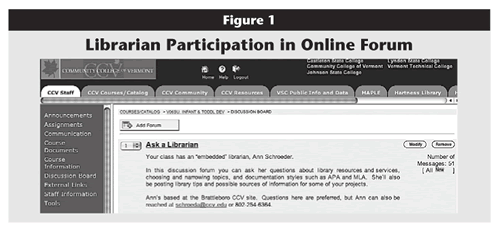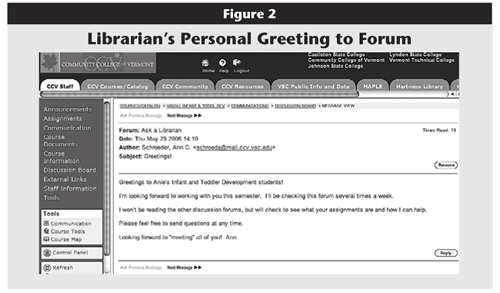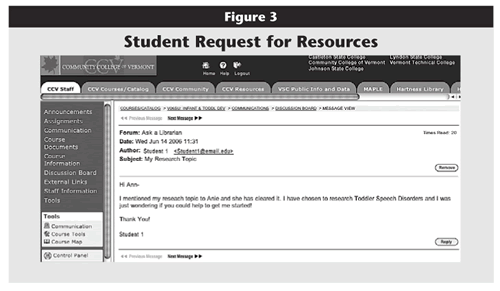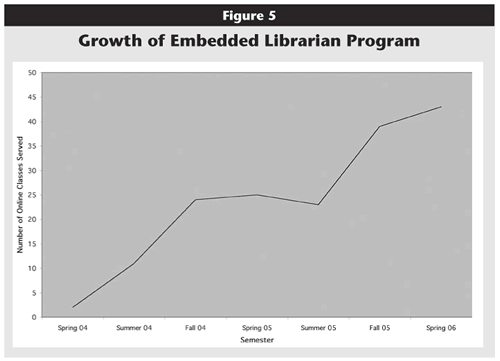With the huge increase in online learning at colleges around the country, libraries need to consider how to serve the growing contingent of online students. Some typical library services include a Web site, remote access to databases, e-mail assistance, a toll-free phone number, a procedure for supplying library materials to students, FAQs, interlibrary loan, and online tutorials. Tutorials come closest to replacing traditional course-based library instruction, but without the human element. Offering students an array of library services not directly related to their classes, however, doesn't make for meaningful and integrated library instruction. As Skank and Dewald explained, "... the closer the link between course assignments and library resources to help with these assignments, the greater the likelihood that students will access library information."1
In the spring of 2004, we began moving away from providing students with a disjointed array of online services and toward an electronically based, integrated library instruction model. The approach we adopted involved embedding a librarian in an online course. The librarian answered students' questions and posted research help relevant to the course assignments. Here we discuss the program's genesis and rapid growth, as well as its benefits and challenges.
On-Campus Library Instruction at CCV
At the Community College of Vermont (CCV), library instruction has proved most meaningful to students when presented within the context of a specific class and preferably in relation to a specific assignment. Indeed, Bergen and MacAdam found that, "... students prosper most from any form of library instruction when it comes at a time of greatest need and relevance to their academic work."2 At CCV, librarians connect with professors—prior to the beginning of a course as well as during a course—regarding their students' research needs and then customize library instruction accordingly. Library databases are often featured in the sessions, but if assignments involve finding different types of resources, such as graphics or statistics, other resources are incorporated. In most cases, hands-on instruction is provided to students. With 12 campuses distributed throughout the state and the equivalent of five full-time library instructors, librarians often travel an hour or more to present these customized sessions to students as requested by faculty.
Serving Online Students
This on-site model has meant that students who take classes online generally miss out on library orientations and instruction. Given the rapid growth in the number of online courses at the college—from 8 courses in the fall of 1997 to 181 courses in the spring of 2006—the lack of library instruction for online students became a problem. When author Victoria Matthew began teaching online at CCV in the spring of 2004, she began working with author Ann Schroeder, CCV librarian, to figure out how to meet this challenge.
CCV's method of providing library instruction to campus-based students works well, so we tried to come up with an online equivalent. This gave rise to the embedded librarian idea, which involves incorporating library instruction into an online class. In spring 2004, for the first iteration of the embedded librarian concept, Schroeder became a teaching assistant in Matthews's Introduction to Psychology course and participated in the students' mid-term paper discussion forum and the end-of-semester paper discussion forum. Figure 1 shows an example of how such a forum might look in an online class. The text outside the forum area explains the concept of the embedded librarian and outlines the librarian's role.

Click image for larger view.
The concept was simple yet effective. The librarian enters the online discussion forum and opens the discussion by introducing herself and explaining her expected availability and involvement in the class (Figure 2).

Click image for larger view.
Students are then free to ask questions. For example, in Figure 3 a student contacts the librarian about the topic of toddler speech disorders and requests additional resources.

Click image for larger view.
The librarian responds to the student's request (Figure 4) with a positive comment on the topic and advice on databases and other resources, including links to the sources and instructions on using them. The amount of time spent crafting responses varies; some responses are quick, whereas others require more specialized research. Still others can be adapted from a list of responses to frequently asked questions that the librarian has compiled over multiple semesters.

Click image for larger view.
Answering students' questions within the forums is just one service. The librarian also posts tips about finding and narrowing topics, choosing and using library databases and resources, and incorporating research using American Psychological Association (APA) and Modern Language Association (MLA) style.
Expanding the Program
The process and the outcomes impressed us, and students appreciated the support so much that we advertised the program to all online faculty for subsequent semesters. The program grew from two courses that first semester to 43 in spring 2006 (see Figure 5). Part of the growth can be attributed to the professors who take advantage of the program semester after semester and share with their colleagues how it has benefited them and their students. One professor wrote, "The students you helped in my marketing class had much, much better projects than those who did not benefit from your expertise. Thank you!"

Click image for larger view.
Another part of the program's growth resulted from the librarian's advertising efforts. At the start of each semester, the librarian sends an e-mail to all online instructors describing the embedded librarian program and providing examples of the different ways instructors have integrated an embedded librarian into their courses. We also worked closely with the assistant library director when developing training materials for new online and hybrid instructors, in an effort to promote the use of this effective program.
Variations of the Model
In addition to seeing growth in the number of students served, the embedded librarian program has also seen growth in the number of innovative ways the initial idea has been customized to serve the needs of specific students and classes. For example, in CCV's Seminar in Educational Inquiry capstone class, the professor created an "Ask the Librarian" thread within each weekly discussion forum. This proved effective because students working on their capstone project could ask the librarian for help every step of the way.
In the Introduction to Online Teaching class—a class designed to introduce faculty to online teaching—the embedded librarian worked with participants on their small-group projects for one week of this five-week class. This model exposed faculty to the CCV library resources and the embedded librarian concept in a focused manner.
In Microcomputer Applications II, an embedded librarian assists students for one week per semester when they are learning how to do research on the Internet. In CCV's Family Law class, the embedded librarian assists students for the three weeks in which they locate Vermont Statutes. Both the Microcomputer Applications II and the Family Law implementations work well because the librarian is incorporated into the class during those weeks when students can most benefit from their assistance while working on research-focused assignments.
Other models implemented have been found wanting. For example, adding an "Ask the Librarian" thread to each weekly discussion in a class that had a paucity of research-based assignments and content meant the librarian spent a lot of time checking into weekly discussions even though her services were not called upon. Other instructors have tried to engage students in the concept of asking the librarian by requiring them to ask a question. While this idea is theoretically sound, it proved ineffective if the students were not working on an assignment that required the assistance of a librarian. What resulted was a slew of random questions, unrelated to course content; this can feel like busy work for both the students and the librarian.
Challenges Encountered
In spite of the program's growth, popularity, and overall success, we have encountered challenges along the way. One concerns defining the librarian's role and deciding how he or she should be involved in the course. This requires striking a balance between implementing best practices and meeting the students' specific needs. Thanks to innovative experimentation by the librarians and participating faculty, we have found that the program works best when:
- The librarian works with students on specific research-focused assignments. When a librarian is embedded in a course that lacks an explicit research component, the librarian's services go untapped.
- "Ask the Librarian" is built into the specific assignments. Students are more likely to use the embedded librarian service if the assignment for that week either requires or reminds them to do so.
- Faculty members reiterate to students the importance of asking the librarian. In keeping with Scheuermann's findings, it was determined that, "... if the professor doesn't encourage and foster engagement between the student and the librarian, it may not happen."3
- An "Ask the Librarian" forum is set up in the discussion board. Students can post questions in this forum throughout the semester. This approach works best because students get accustomed to seeing and using the forum. Having a single forum also means that the librarian can quickly and easily check for questions from students in a single place rather than multiple ones.
While it is important for librarians to recognize the exciting potential of new models—indeed, these faculty experiments resulted in a wide array of successful models—it is also important for faculty to recognize the librarian's experience with this program and be open to suggestions for improvements to the proposed model. A partnership approach to the program works best.
Other challenges include students' e-mailing rather than posting a question in the discussion forum for the librarian. This circumvents what Skank and Dewald highlight as one of the advantages of hosting discussions online, that is, students benefit from the postings by and for other students.4 Librarians therefore respond to the student's e-mail but also ask the student to post the question and the response to the forum so that other students can gain insight from the exchange.
Some faculty members have come to rely on the program after two years and expect library assistance automatically each semester. While a testament to the program's success, this expectation can prove problematic because CCV does not have enough librarians to provide the service in every online class. Consequently, some faculty have been turned away after a predetermined number of courses has been reached. This points to a larger concern, which is the inability—given a finite number of librarians—to continue to grow the program in its current form.
Into the Future
Because of the finite number of librarians, CCV has begun to examine alternate approaches. One approach involves creating library courses for specific curricular areas. Another is videoconferencing.
Library Courses for Specific Curricular Areas
Work has begun on a pilot library support course for the social sciences. By having one course for social sciences, content can be posted—about APA documentation style, for example—just once, rather than in every social science course.
Using this model, students can also access resources by curricular area, including Web links, RSS feeds, and tutorials and instructions specific to social science databases. The previous library Web site included curricular-specific resources, but they were not incorporated in the new library Web site. Library courses for curricular areas are a practical place to store those links.
Discussion forums by curricular areas have also been created for this pilot course, including separate forums for anthropology, psychology, and sociology. This means students can see what other students have posted, which may prevent the need to repeat something already said. It could also ultimately result in a knowledge base of FAQs. In addition, one discussion forum for all psychology classes, for example, might help build a sense of community among students studying in the same curricular area who live many miles apart and may never meet in person.
We foresee working with the college's social science committee to further develop this resource. It will be marketed directly to faculty through the CCV portal and through academic coordinators responsible for hiring, mentoring, and supervising social science instructors.
For fall semester of 2006, the library envisions offering online instructors a choice of either an embedded librarian or enrolling their students in a library support course, with the former option being available on a first come, first served basis. An alternate approach is provided by Central Missouri State University, which has automatically enrolled all students from two disciplines into Blackboard library courses for those disciplines.5
IP Videoconferencing and NetMeeting
Another technology tried with great success is a combination of IP videoconferencing and NetMeeting software. This particular approach was implemented to meet the needs of either campus-based or hybrid students (students whose classes are a combination of Web-based and campus-based learning) at remote CCV sites where a librarian was not readily available in person.
CCV began experimenting in 2002 with IP videoconferencing using VCON's high-definition set-top system. In fall 2004, IP videoconferencing was implemented for college-wide meetings. With multiple campuses plus a central office, staff meetings previously involved extensive driving; the implementation of this technology has significantly increased time on the job and decreased travel expenses. It has also meant that college constituents stay more connected because they no longer feel hesitant about scheduling meetings with the need to drive eliminated.
In fall 2005, CCV's Learning Technologies Committee—on which we both serve—began discussing the idea of using IP video for the delivery of college-wide technical training. They began experimenting with NetMeeting in conjunction with IP video so that applications could be shared with those participating in videoconferences.
In spring 2006, the librarian decided to roll out these technologies to a wider audience by using a combination of IP video and NetMeeting to teach library instruction to a class at a remote site. The librarian was in Brattleboro and the class in Newport, 175 miles apart. IP video allowed students to see, hear, and communicate with the librarian during the session, while NetMeeting let them see the librarian's desktop as she demonstrated accessing library databases and other resources.
IP video was running at both sites. Each site then logged onto their computers, and someone at Newport (where the students and instructor were located) determined the IP address of their machine and shared that over IP video with the librarian in Brattleboro. Both sites then launched NetMeeting, and the librarian "shared" her desktop with the students by entering the remote site's IP address into NetMeeting.
The four library instruction sessions done so far have been deemed successful, but technical and teaching style challenges arose. The technical challenges included:
- After 9–10 minutes of inactivity, the computer on the receiving end reverted to a screen saver, requiring users to log in using their password, so someone stationed at the receiving computer must periodically wiggle the mouse. Because the screensaver is a security measure, the IT department is uncomfortable with the idea of changing the function on any specific computer. Videoconferencing attendees will have to tolerate this situation until an alternate solution is found.
- Locating the IP address of the receiving computer is a complex process, so staff need special training and step-by-step instructions, which must be created and distributed.
- Due to bandwidth issues caused by a high volume of traffic on the network at different times of day, the video image is sometimes slightly behind the audio and the image of the shared computer desktop.
In addition to technical problems, teaching style challenges came up:
- Because of the delay in the video image, the librarian must pause between sentences to allow time for questions.
- With eye contact not possible, it was harder to forge a connection with the class.
- The librarian was accustomed to walking around while teaching and had to change her style to stay visible on the IP video screen.
Following the pilot sessions, the librarian, staff, and instructors came up with several recommendations for successful IP video/NetMeeting sessions:
- Coordinate the set-up and monitoring on the remote end so that the technology is ready to go when the instructor and students enter the computer lab.
- Coordinate handout distribution in advance. This is particularly important when a librarian is not present to help students through the pointing and clicking process or when the various functionalities are only demonstrated and students do not have the opportunity for hands-on practice.
- Take into account possible delays in the video by pausing while speaking.
- Consider splitting the session into lecture and hands-on practice with questions.
- Discuss the protocol for asking questions in advance. With only one microphone per IP video unit, not all students can sit close enough to the microphone to ask questions.
- Think about your teaching style given the camera set-up. Either strive to adopt a stationary stance in front of the camera or zoom the camera out a little so that it can capture your movements around the room.
Conclusions
As a distributed campus with sites across the state of Vermont, CCV faced some real challenges when it came to serving all its campuses and a growing number of online students with a handful of instructional librarians. CCV's embedded librarian program demonstrates how, through a partnership approach with faculty, comprehensive library instruction can be provided for online students in a meaningful and integrated way. The morphing of this model into library course sites for curricular areas demonstrates how community portal technology can remedy restrictions in growth and help foster a sense of community among students. The use of IP videoconferencing and NetMeeting for library instruction illustrates how to efficiently provide just-in-time training to students on satellite campuses.
Given the continued growth in online programs and the need to focus on incorporating information literacy in classroom instruction, CCV's various approaches to library instruction can benefit many. The most important lesson to be learned, however, is the need to innovate, cooperate, and experiment. When librarians and faculty work together in an environment of trust and openness, mistakes might be made, but perceived obstacles can be overcome and lessons learned. These lessons can positively affect the way we serve students.
